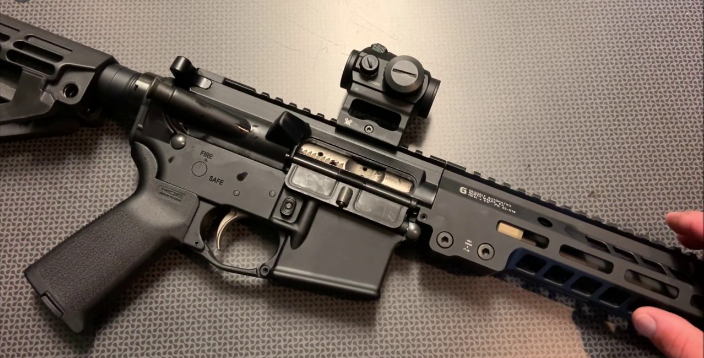Photos: YouTube\Twitter
“Like the Swiss Army knife, the popular AR-15 rifle is a perfect combination of home defense weapon and homeland defense equipment. Good for both home and battle.” This is the opening paragraph in Friday’s California Federal Court order in Miller v. Bonta, (previously Miller v. Becerra) in which a federal U.S. District Court judge overturned California’s 30-year-old ban on assault weapons, ruling that the California law violates the constitutional right of all Americans to bear arms.
California Governor Gavin Newsom’s response was swift: “This decision is a direct threat to public safety & the lives of innocent Californians. Comparing an AR-15 to a Swiss Army Knife is a slap in the face to those who lost loved ones to guns. We won’t back down & we will fight for common sense gun laws.”
John Lawlor, a South Florida lawyer, reminds us that this isn’t just a California issue.
“What this District Court decision in California shows us is that we have reached a point where everyone from regular hardworking people to federal judges have become desensitized to gun violence to the point that comparing an AR-15 to a Swiss Army knife is something that far too many of us feel comfortable doing.”
There will be plenty of articles that dissect this decision in significant legal detail over the next few days, but what’s interesting to many people, including those with a deep interest in technology, is the Swiss Army Knife reference, as this is a famed, beloved, and, evidently, deeply misunderstood tool.
In 1897, the original Swiss Officer’s and Sports Knife was patented, 13 years after Swiss technologist Karl Elsner opened a knife shop and began working on prototypes.
This marks the invention of the tool known around the world today as the “Swiss Army Knife”. While there are many brands who for decades have tried to copy this knife (some have made beautiful, highly functional tools), the term Swiss Army Knife belongs to the company that is the evolution of that of Herr Elsner, and that is Victorinox, which he named after his mother, Victoria (and “inox” is non-corrosive, stainless steel).
Victorinox is currently regarded as a high-end brand among those in the know. They make high-end technical clothing, some superb watches, and, of course, what is still known as the original Swiss Army Knife. The Swiss Army knife is a brilliant piece of technology. What began with the implements Elsner deemed to be the most essential – blade, scissors, pen (yes, a pen), screwdriver (which, as the founder of a watch company, your author can assure you works great for minor watch repairs in the field), a screwdriver, nail file, and key ring – have now evolved dramatically.
The Swiss Army knife of today is a thing of wonder, and can include biometric fingerprint technology, lights, and Bluetooth remote control. Yes, you can essentially use a Swiss Army Knife as a digital hub. As far back as a decade ago, the MIT Technology Review touted the Swiss Army knife as, well, the Swiss Army Knife of cutting (sorry) edge tech. The $300 Flash Collection was a Swiss Army Knife with a drive, laser pointer, and lights galore.
This wasn’t just a drive. As the MIT Technology Review pointed out, this was state of the art technology for 2011:
“The company held a contest this year offering a quarter of a million bucks to anyone who could access encrypted information on a Victorinox drive. No one could.”
The future of the Swiss Army Knife is literally and virtually limitless. Size doesn’t matter anymore. The original Swiss Army Knife was 100 mm (3.9 in) long, 16.5 mm (0.65 in) thick and weighed 125 g (4.4 oz). In theory, today, something this size could power a nuclear arsenal. As all of our technology becomes more powerful and smaller, it will be possible to have something the size and weight of the Swiss Army Knife power the entirety of our digital lives, acting as the crucial baseline hub that keeps us always connected to other devices, to each other, to our healthcare providers, to professionals whose job it is to help or even save us.
So, fundamentally, the Swiss Army Knife remains from a philosophical perspective the same tool it has been throughout its 137-year history from prototype to today: It is a tool that helps people.
Contrast the Swiss Army Knife with “the popular AR-15 rifle.” As the U.S. District Court did on Friday.
Forty years ago, in his timeless essay in The Atlantic, James Fallows described the military origins of the AR-15 rifle. He followed it up with what is, sadly, an equally timeless 2017 piece on how mind-knowingly lethal the AR-15 actually is.
The AR-15 has played the starring role in America’s endless and tragic series of mass-killings. There are two critically important reasons why the AR-15 is the technology of choice for mass murderers:
The reliability and the bullets. Because in the history of firearms, nothing even comes close to touching the AR-15.
Fallows reported the central problem with the predecessor to the AR-15, the M-16:
“The problem with the M-16, from the perspective of many of the Americans who had been using it during the 1960s and 1970s in Vietnam, is that it too often failed at the fundamental task of combat weaponry: killing troops on the other side.”
That’s both the beauty and deep tragedy of the post-modern civilian version of the M16 – the AR-15 doesn’t jam. It’s a turnkey killing machine, requiring only basic gun knowledge to use, minimal and infrequent maintenance, and awe-inspiring results.
It’s one thing for a weapon to work, but what a gun really comes down to is what it’s projecting at and into other human bodies with the intent of ending said body’s time on Earth.
Fallows observes:
“The AR-15, created by the celebrated armaments designer Eugene Stoner, had many advantages, but a crucial one was that it used smaller, lighter bullets than some predecessors, which traveled at higher speed.”
It is precisely this higher speed that makes the AR-15 bullets so deadly.
“A little bullet pays off so much in wound ballistics. That is what people who choose these weapons know.”
Michael Epstein, a personal injury lawyer who has represented many gun violence victims, has seen the damage.
“It’s not only the frequency of gun violence in the nation today, it’s the intensity. Any weapon that has the power of an AR-15 is capable of massive damage in an instant. We should know this by now and should be preserving laws that serve and protect us.”
So, yes, insofar as the Swiss Army Knife the judge envisioned is equally adept at filing a hangnail and snipping a loose shirt button string, the AR-15 is equally adept at executing people at a music festival as it is in killing a classroom full of defenseless young children.
If this is the calculus Federal judges are applying today, then perhaps this is America.
As to whether Friday’s decision is going to enjoy the same 30-year run as did the California assault weapons ban, much will depend upon the path this and other cases take. While many pundits are already dismissing the shelf life of Miller v. Bonta, if it or a similar case reaches the Supreme Court, it may become the law of the entire nation. This current incarnation of the Supreme Court of the United States is a 6-3 conservative majority with some foundational decisions, such as the future of abortion, already on the calednar for the upcoming October term. How activist a Court this will be remains to be seen, but a reorganized and soon revitalized National Rifle Association and closely-aligned lobbying groups will be primed for the fight.
So, as to the title of this piece, the reality is that 40,000 Americans are killed each year by guns. A Swiss Army Knife is not an assault rifle, and for a federal court to rule that there is any similarity between the two, aside from the fact that they are both “things,” marks how far American society has slid down that slope we knew was slippery but never would have predicted would slide us all the way here.
Aron Solomon is the Head of Strategy for Esquire Digital and an adjunct professor of business management at the Desautels Faculty of Management at McGill University. Since earning his law degree, Solomon has spent the last two decades advising law firms and attorneys. He founded LegalX, the world’s first legal technology accelerator and was elected to Fastcase 50, recognizing the world’s leading legal innovators. His work has been featured in TechCrunch, Fortune, The Independent, TechCrunch Japan, Yahoo!, ABA Journal, Law.com, The Boston Globe, The Hill, and many other popular publications.







